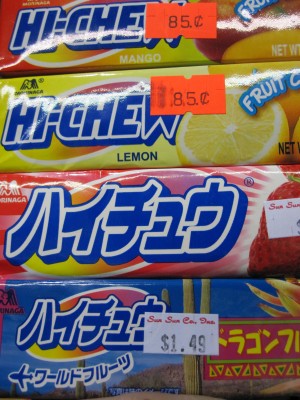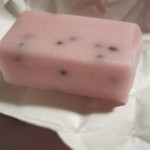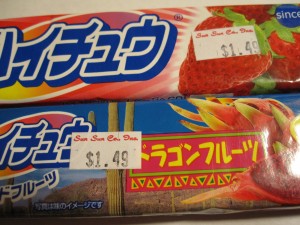
Hi-Chew is the smarter, sexier, tastier Japanese cousin of Starburst.
The candy is less sweet than Starburst, with a more authentic-to-the fruit taste. It has a rubbery feel in the teeth at first, but I think this makes the candy more long-lasting than the quick-to-dissolve, sugary Starburst. It comes in a variety of fruit flavors- the American line, according to the website, consists of Strawberry, Green Apple, Grape, Mango, Orange and Melon. However, the Japanese line is much more extensive, including exotic choices such as Cantaloupe, Blood Orange, Passion Fruit, Yuzu, Grapefruit, and the one I snagged the other day in a Chinatown supermarket, Dragon Fruit.
 This flavor is unusual because it actually contains what I assume are dragonfruit seeds embedded in the candy itself. It adds an interesting textural component to the eating experience. The dragonfruit flavor tastes like strawberry or raspberry yogurt, which isn’t a bad thing.The mango flavor is the favorite of many of my Hi-chew aficionado friends, and I must agree that its mellow sweetness very closely resembles an actual piece of mango. The lemon has a brighter, more fragrant lemon taste than its Starburst counterpart. And the strawberry tastes pretty much like a strawberry.
This flavor is unusual because it actually contains what I assume are dragonfruit seeds embedded in the candy itself. It adds an interesting textural component to the eating experience. The dragonfruit flavor tastes like strawberry or raspberry yogurt, which isn’t a bad thing.The mango flavor is the favorite of many of my Hi-chew aficionado friends, and I must agree that its mellow sweetness very closely resembles an actual piece of mango. The lemon has a brighter, more fragrant lemon taste than its Starburst counterpart. And the strawberry tastes pretty much like a strawberry.
I really like the colorful packaging. On the left is the name HI-CHEW, or the Japanese characters. The packs feature a picture of the fruit it is meant to taste like. I particularly enjoy the holy rays of light coming off of the strawberry, and the cacti-ed desert of the dragonfruit.

Hi-chew can be found in most Asian supermarkets, though I purchased mine in Chinatown. As you can see in the picture, I paid 85 cents for a 1.76 oz candy, and $1.45 for a 1.9 oz stick. For comparison, a Starburst pack retails at Buick St Market for $1.39 for a 3.45 oz pack, 160 calories per serving (which is about half the pack). The Hi-Chew package claims the serving size to be the whole pack, at 210 calories per serving for the small package (American version), and 160 calories for the longer pack (Japanese version). I am unsure what accounts for this calorie discrepancy, other than perhaps conversion issues? On the ingredient list, the Japanese version lists corn syrup where the American contains glucose syrup, but I’m fairly certain there is no great caloric difference between glucose and corn syrup. Both versions contain real fruit puree of the flavor they are intending to mimic.
Verdict: If you’re going to Chinatown or Super 88, buy some. Definitely the Mango if you like mango, as well as any other flavors you dare to try.If you always thought Starburst was a little too sweet, this is definitely the candy for you.


Good review!
I have seen them in the stores tried them only once. But you are right the Starburst flavors are a lot stronger.